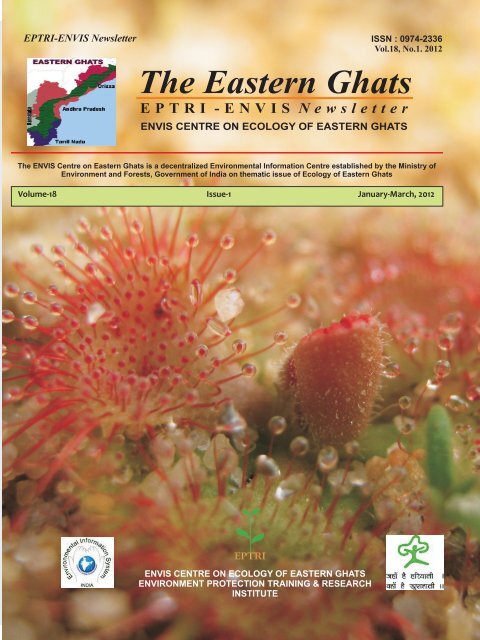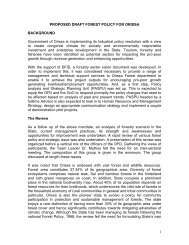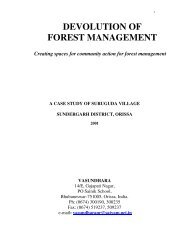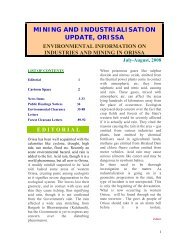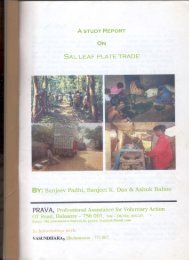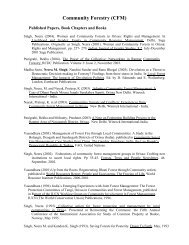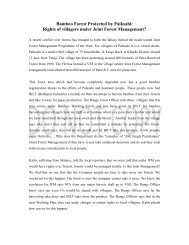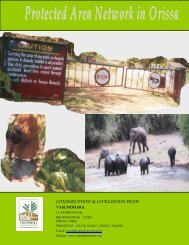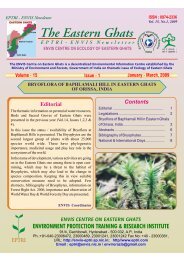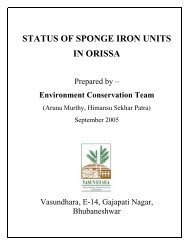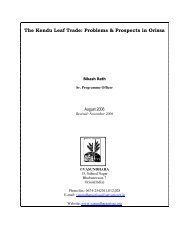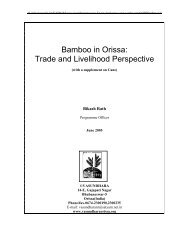Bio-Diversity and Cultural Aspects of Mahendragiri, in ... - Vasundhara
Bio-Diversity and Cultural Aspects of Mahendragiri, in ... - Vasundhara
Bio-Diversity and Cultural Aspects of Mahendragiri, in ... - Vasundhara
- No tags were found...
Create successful ePaper yourself
Turn your PDF publications into a flip-book with our unique Google optimized e-Paper software.
EPTRI-ENVIS NewsletterISSN : 0974-2336Vol.18, No.1. 2012The Eastern GhatsE P T R I - E N V I S N e w s l e t t e rENVIS CENTRE ON ECOLOGY OF EASTERN GHATSThe ENVIS Centre on Eastern Ghats is a decentralized Environmental Information Centre established by the M<strong>in</strong>istry <strong>of</strong>Environment <strong>and</strong> Forests, Government <strong>of</strong> India on thematic issue <strong>of</strong> Ecology <strong>of</strong> Eastern GhatsVolume-18 Issue-1 January-March, 2012ENVIS CENTRE ON ECOLOGY OF EASTERN GHATSENVIRONMENT PROTECTION TRAINING & RESEARCHINSTITUTE
The Eastern Ghats, EPTRI - ENVIS Newsletter Vol.18, No.1, 2012CONTENTSPage no.1. Editorial 22. Forth Com<strong>in</strong>g events 2THE EASTERN GHATSENVIS NEWSLETTERVOL.18, No 1,20123. <strong>Bio</strong>-<strong>Diversity</strong> <strong>and</strong> <strong>Cultural</strong> <strong>Aspects</strong><strong>of</strong> <strong>Mahendragiri</strong>, <strong>in</strong>Eastern Ghats<strong>of</strong> India34. Abstracts 8EDITORIALIn this issue <strong>of</strong> the Eastern Ghatsnewsletter an article deals withthe <strong>Bio</strong>-<strong>Diversity</strong> <strong>and</strong> <strong>Cultural</strong> <strong>Aspects</strong> <strong>of</strong><strong>Mahendragiri</strong>, <strong>in</strong> Eastern Ghats <strong>of</strong> India,where Culture <strong>and</strong> Nature Coexistsforth com<strong>in</strong>g events <strong>and</strong> News & Eventsare presented.Cover Page:Drosera burmaniiPhoto Credit: M.GiridharENVIS COORDINATORFORTH COMING EVENTSTitle: International Conference on Forest Mounta<strong>in</strong> & People 2012Date: 5 to 6 July 2012Venue: K<strong>and</strong>y, Sri LankaOrganizer: International Center for Reserach & Development(ICRD)Email/Contact person: Prabhath PatabendiWebsite: http://www.futureevents.orgLast date for abstract: 31 March 2012ENVIS TeamDr. Razia Sultana, ENVIS Coord<strong>in</strong>atorMr. B.L.N. Murthy, Program <strong>of</strong>ficerMr. M.Giridhar, Program OfficerSmt J.V.S. Prabhavathi, Data Entry OperatorPublished byEPTRI, HyderabadSupported byM<strong>in</strong>istry <strong>of</strong> Environment <strong>and</strong> Forests(MoEF)2
The Eastern Ghats, EPTRI - ENVIS NewsletterAbstract:<strong>Bio</strong>-diversity <strong>and</strong> <strong>Cultural</strong> <strong>Aspects</strong> <strong>of</strong><strong>Mahendragiri</strong> <strong>in</strong> Eastern Ghats <strong>of</strong> India.Prasad Kumar Dash* <strong>and</strong> P. W. Jaykumar Choudhary*Plant Ecologist,Community conservation <strong>and</strong> Forest Governance Theme<strong>Vasundhara</strong>, Odisha.Guest Faculty <strong>in</strong> Zoology, P.G. Department <strong>of</strong> Life Sciences, SKCG College, ParalkhemundiThe <strong>Mahendragiri</strong> hills on the Eastern Ghats <strong>of</strong> Indiaare floristically, archeologically <strong>and</strong> ecologicallyimportant habitat as they harbour both the Northern<strong>and</strong> Southern Indian floral elements. A vegetationsurvey was conducted <strong>in</strong> <strong>Mahendragiri</strong> hills todocument the floral diversity <strong>of</strong> the region onNovember, 2010 which yield 679 species <strong>of</strong> plantsthat <strong>in</strong>cludes 3 species <strong>of</strong> gymnosperms, 676 species<strong>of</strong> angiosperms under 453 genera <strong>and</strong> 115 families.Polygala crotalarioides var. glabrescens, Gnetummontanum, Drosera burmanii, Drosera <strong>in</strong>dica <strong>and</strong>Bupleurum falcatum are reported for the first timefrom the hill. Similarly many Rare, Endangered <strong>and</strong>Threatened plants were recorded dur<strong>in</strong>g the surveythat <strong>in</strong>cludes species <strong>of</strong> both northern <strong>and</strong> southernIndian floral composition. <strong>Mahendragiri</strong> hill forestcomplex acts as the carbon s<strong>in</strong>k <strong>and</strong> water tower, thusplays a pivotal role <strong>in</strong> ma<strong>in</strong>ta<strong>in</strong><strong>in</strong>g the ecologicalbalance <strong>and</strong> climate control <strong>of</strong> the entire southOdisha <strong>and</strong> Srikakulum district <strong>of</strong> Andhra Pradesh.Irrespective <strong>of</strong> the rich floral diversity, the hills areunder severe threat <strong>of</strong> deforestation <strong>and</strong> degradationdue to several anthropogenic activities. To protect<strong>and</strong> conserve the ancient sacred hill, it is nowimperative to declare <strong>Mahendragiri</strong>-S<strong>in</strong>garaj-Badadeva-Devagiri system cover<strong>in</strong>g more than 5,000sq km as a <strong>Bio</strong>sphere Reserve or <strong>Bio</strong>diversityHeritage Site. A detailed <strong>and</strong> seasonal survey on allgroup <strong>of</strong> life forms <strong>of</strong> the hill need to be documentedbefore prepar<strong>in</strong>g conservation <strong>and</strong> management planIntroduction:The 5,000 feet high <strong>Mahendragiri</strong>-S<strong>in</strong>gharaju hills,situated <strong>in</strong> the middle <strong>of</strong> Eastern Ghats <strong>in</strong> theParalakhemundi sub-division <strong>of</strong> Gajapati district is175 km away from Berhampur. It is a treasure <strong>of</strong>plant genetic wealth <strong>and</strong> be<strong>in</strong>g treated as criticalhabitat <strong>of</strong> Saura, a primitive tribal Group (PTG) <strong>of</strong>India. As per Gamble (1892), <strong>Mahendragiri</strong> is theamalgamation <strong>of</strong> biodiversity with species from bothnorth <strong>and</strong> south, the Himalayas <strong>and</strong> the Nilgiris.Theannual ra<strong>in</strong>fall is 1551.6 mm. Spread over an area <strong>of</strong>over 2,000 sq km border<strong>in</strong>g Andhra Pradesh, thismajestic micro-environmental terra<strong>in</strong> is dotted with3Vol.18, No.1, 2012over 25 small <strong>and</strong> big hills among which S<strong>in</strong>garaj(1516 meters), <strong>Mahendragiri</strong> (1601 meters) <strong>and</strong>Devagiri (1392 meters) are the highest peaks <strong>in</strong> theregion form<strong>in</strong>g a golden triangle symboliz<strong>in</strong>g thearea's immense ecological asset.The lush greentropical forests (semi ever green to moist <strong>and</strong> drydeciduous type) <strong>of</strong> <strong>Mahendragiri</strong> acts as atransitional zone between flora <strong>of</strong> southern India<strong>and</strong> the Himalayas mak<strong>in</strong>g the region an ecologicalestuary <strong>of</strong> genetic diversities which provideslivelihood to the Saura's. The archeologicalimportance <strong>of</strong> the hills <strong>in</strong>cludes Kunti temple,Parshuram temple, Bhima temple, Yudhisthirtemple, Hanuman temple etc. which are <strong>of</strong> prehistoric ages. Sivaratri is the ma<strong>in</strong> festival herewhich draws a large crowd. This testifies the factthat it was once a centre <strong>of</strong> Saivite culture.Ecologically, the <strong>Mahendragiri</strong> terra<strong>in</strong> is <strong>in</strong> a verybad shape today as the vegetation cover has becomevery th<strong>in</strong> except <strong>in</strong> the valleys due to anthropogenicactivities, lack <strong>of</strong> alternative livelihoods <strong>and</strong> legalprotection <strong>of</strong> traditional knowledge. Both the plantwealth <strong>and</strong> <strong>in</strong>digenous knowledge are <strong>in</strong> imm<strong>in</strong>entdanger.Geology:The rocks <strong>of</strong> <strong>Mahendragiri</strong> hills belong to granite<strong>and</strong> magnetiteDra<strong>in</strong>age:Mahenragiri is the orig<strong>in</strong> po<strong>in</strong>t <strong>of</strong> two importantrivers <strong>of</strong> south Odisha <strong>and</strong> Andhra Pradesh. Thepr<strong>in</strong>cipal dra<strong>in</strong>age systems are Bahuda Riveremanated from S<strong>in</strong>garaju peak, Ghodahada River animportant tributary <strong>of</strong> Rushikulya starts fromRamgiri <strong>of</strong> Dhoba dhobani hill ranges <strong>and</strong> jo<strong>in</strong>sRushikulya at H<strong>in</strong>jilikatu, Sana nadi, a tributary <strong>of</strong>Vamsadhara starts around R. Udyagiri <strong>and</strong> jo<strong>in</strong>sVamsadhara at Gunpur. Similarly, Mahendratanayawest, a pr<strong>in</strong>cipal tributary <strong>of</strong> Vamsadhara has cutacross mahendraparvat <strong>and</strong> jo<strong>in</strong>s Vamsadhara atParalakhyamundi, another Mahendratanaya startsfrom <strong>Mahendragiri</strong> peak <strong>and</strong> flows via M<strong>and</strong>asa <strong>and</strong>Baruva <strong>and</strong> f<strong>in</strong>ally jo<strong>in</strong> sea on the east.Study site:<strong>Mahendragiri</strong> hilly terra<strong>in</strong> is located <strong>in</strong> Survey <strong>of</strong>India topographic maps 74 A/4, A/8, 74B/1 <strong>and</strong>74B/5 <strong>in</strong> Paralakhemundi division <strong>of</strong> Gajpatidistricts <strong>of</strong> Odisha (Fig 1). Follow<strong>in</strong>g peaks are thecharacterstic features <strong>of</strong> the hill which
The Eastern Ghats, EPTRI - ENVIS Newsletterdist<strong>in</strong>guishes the other floristic habitat <strong>of</strong> Odishafrom <strong>Mahendragiri</strong> <strong>in</strong> terms <strong>of</strong> ecological factors(Table 1).Table 1: Mounta<strong>in</strong> peaks <strong>of</strong> <strong>Mahendragiri</strong>Name Relative Location Altitude(mts)S<strong>in</strong>garaz North <strong>of</strong> <strong>Mahendragiri</strong> 1,516Mahendra- North-East <strong>of</strong> Ka<strong>in</strong>pur 1,501giriDevagiri South <strong>of</strong> Gumma 1,382Badadeba East <strong>of</strong> Ramagiri-Udaygiri 1,364Idongiri/ West <strong>of</strong> <strong>Mahendragiri</strong> 1,323IndragiriLuaba South-East <strong>of</strong> R. Udayagiri 1,260Seranga North <strong>of</strong> Seranga 1,150Gumma South-East <strong>of</strong> Gumma 1,094Figure-1: Location <strong>of</strong> <strong>Mahendragiri</strong> <strong>in</strong> Eastern Ghats<strong>of</strong> IndiaVol.18, No.1, 2012Previous floristic accounts <strong>of</strong> <strong>Mahendragiri</strong> hillcomplex:The first floristic account <strong>of</strong> <strong>Mahendragiri</strong> wasdealt by Gamble (1915-35) <strong>in</strong> 1892 who is known asthe pioneer researcher to document the flora.Subsequently Mukharjee (1935); Kapoor (1964);Bramham <strong>and</strong> Saxena, 1981, 1984; Paul et al.,1980; P<strong>and</strong>a <strong>and</strong> Tripathy (1993) had botanised thehill. Similarly Saxena <strong>and</strong> Brahmam (1994)enumerated the floristic account <strong>of</strong> mahendrgirihills <strong>in</strong> the book Flora <strong>of</strong> Orissa. However Kapoordescribed only 2 species <strong>of</strong> orchids from thisregion. Later Mishra (1983, 1993) <strong>and</strong> P<strong>and</strong>a et al.(2010) represented 36 species <strong>of</strong> Orchids from<strong>Mahendragiri</strong>.Results <strong>and</strong> discussion:Sacred Sites <strong>of</strong> <strong>Mahendragiri</strong>:<strong>Mahendragiri</strong> is the foremost <strong>of</strong> the seven“Kulagiris” or pr<strong>in</strong>cipal mounta<strong>in</strong>s <strong>of</strong> India. It hasbeen referred to <strong>in</strong> ancient literature, accounts <strong>and</strong>epigraphy. It f<strong>in</strong>ds mention <strong>in</strong> the works <strong>of</strong> poetsKalidas <strong>and</strong> Oriya poets Sarala Das <strong>and</strong> RadhanathRay. The archaeological structures here, <strong>in</strong>clud<strong>in</strong>gthe Bhima, Yudistir <strong>and</strong> Kunti temples, which enjoythe status <strong>of</strong> protected monuments under theAntiquate Monument Archaeological Rema<strong>in</strong>s <strong>and</strong>Sites Act 1958, are also under threat. These templesare believed to have been established between thefourth <strong>and</strong> the 10th century AD. All the temples arenamed after the P<strong>and</strong>avas <strong>and</strong> their mother Kunti.Oriya Mahabharata author Sarala Das attributes theestablishment <strong>of</strong> the Gokarnesvara Sival<strong>in</strong>ga toP a n d a v a s , w h o a r e s a i d t o h a v e v i s i t e d<strong>Mahendragiri</strong> dur<strong>in</strong>g their exile. The Kunti templeis 30-ft high <strong>and</strong> is at one end <strong>of</strong> the flat top <strong>of</strong> thehill. The temple has been plastered with lime afterthorough repairs. The “parsvadevatas” <strong>in</strong>cludeGanesha, Kartikeya <strong>and</strong> Pravati. The “nabagrahas”are placed on the l<strong>in</strong>tel over the door jambs. Two<strong>in</strong>scriptions that may be paleographically placed <strong>in</strong>the 12th century are found here.L<strong>and</strong>scape <strong>of</strong> <strong>Mahendragiri</strong> hills4The Yudhisthira temple that rises abruptly from theground level is <strong>in</strong> the “Triratha” style <strong>and</strong> is on theother side <strong>of</strong> the hill's flat top. The outer walls aredevoid <strong>of</strong> any sculptural decoration except<strong>in</strong>g fourChaitya arches. There is no “parsvadevata” here.The l<strong>in</strong>tel <strong>of</strong> the door conta<strong>in</strong>s an <strong>in</strong>scription <strong>of</strong> theChola dynasty.The Bhima temple is assumed byscholars to have been built just after the Guptaperiod <strong>and</strong> appears to be the oldest <strong>of</strong> these temples.
The Eastern Ghats, EPTRI - ENVIS NewsletterIt is made <strong>of</strong> five huge square blocks <strong>of</strong> stones <strong>and</strong>has a low <strong>and</strong> squat tower, square sanctum, squat“sikhara” <strong>and</strong> flat ro<strong>of</strong>. The doorway is narrow<strong>and</strong> the walls do not have any niche. This temple is<strong>of</strong>ten regarded as the Gokarnesvara temple <strong>of</strong> theplace. Apart from these big temples, there are fewsmall statues <strong>of</strong> Lord Hanuman <strong>and</strong> lord Parsuram<strong>in</strong> the hill top where the shola forest exists. Saorasare the ma<strong>in</strong> tribe <strong>in</strong> these hill forests, but theycome under vulnerable tribal group (prmitivetribal group) which are protect<strong>in</strong>g the forest s<strong>in</strong>cemany decades <strong>and</strong> deriv<strong>in</strong>g the eosystem servicesprovided by the hills. More than 2,000 people visit<strong>Mahendragiri</strong> every year. But s<strong>in</strong>ce most <strong>of</strong> themcome for a short visit, elaborate accommodationfacilities are not available.Vol.18, No.1, 2012Vegetation: <strong>Mahendragiri</strong> comes under the Deccanregion <strong>of</strong> Hooker's (1904) n<strong>in</strong>e botanical prov<strong>in</strong>ces <strong>of</strong>British India. Gamble <strong>and</strong> Fisher (1915-35), whilerecogniz<strong>in</strong>g five floristic divisions <strong>of</strong> MadrasPresidency, placed mahendragiri <strong>in</strong> their Sal region.Accord<strong>in</strong>g to Champion <strong>and</strong> Seth (1968), the forests<strong>of</strong> <strong>Mahendragiri</strong> fall under tropical moist deciduoustype. The foot hills <strong>of</strong> the hill range covered with drydeciduous forests. On ga<strong>in</strong><strong>in</strong>g height, this graduallychanges to tropical moist deciduous forests, which ispredom<strong>in</strong>ant <strong>in</strong> larger areas <strong>of</strong> the hills. The uppervalleys come under tropical semi-evergreen forestsmixed with tropical evergreen forests <strong>in</strong> smallpockets. Hence <strong>Mahendragiri</strong> fall ma<strong>in</strong>ly under (a)Sal forests (b) tropical moist deciduous, (c) tropicaldry deciduous, (d) semi-evergreen (e) Grassl<strong>and</strong>s,<strong>and</strong> (f) scrub forests. The forests are also subdivided<strong>in</strong> to Sal forests, semi-evergreen forests, Grassl<strong>and</strong>s<strong>and</strong> scrubs.Sal forests: Sal occurs <strong>in</strong> different plant communities<strong>in</strong> different frequency. Sal forests which occur <strong>in</strong>cont<strong>in</strong>uation with the semi-evergreen type or close tothe moist valleys are classified as tropical moistdeciduous forests. The top storey <strong>in</strong> these forestsconsists <strong>of</strong> predom<strong>in</strong>antly deciduous species whereas the socond storey has some evergreens. Commonassociates are Pteocarpus marsupium, Term<strong>in</strong>aliaspp., Hald<strong>in</strong>ia cordifolia, Madhuca <strong>in</strong>dica etc. Theshrub layer consists <strong>of</strong> etc. The dom<strong>in</strong>ant climbers areBauh<strong>in</strong>ia vahlii, Ardisia solanacea, Barleriastrigosa, Eranthemum pulchellum Cayratia carnosa,Cissus adnata, Cissus repens, Diascorea spp. <strong>and</strong>Smilax macrophylla etc. The ground flora consists <strong>of</strong>Andrographis paniculata, Dicliptera bupleuroides,Justisia simplex <strong>and</strong> many species <strong>of</strong> commel<strong>in</strong>aceae,Z<strong>in</strong>giberaceae <strong>and</strong> poaceae.When the conditions are hot <strong>and</strong> dry, sal is <strong>of</strong> poorquality <strong>and</strong> the forests may be called as tropical drydeciduous type. The important associates <strong>of</strong> Sal areAnogeissus latifolia, Diospyros melanoxylon,Dendrocalamus strictus, Mallotus philippensis etc.The shrub layers consist <strong>of</strong> Cleistanthus coll<strong>in</strong>us,Zigiphus spp., <strong>and</strong> Carissa spp. The climbers <strong>in</strong>cludeAcacia spp., Cayratia auriculata, Ampelocissustomentosa, Ventilago madraspatana <strong>and</strong> Combretumroxburghianum.Moist deciduous forests: Bellow the ridge on steepslopes the mixed forests are found which are divided<strong>in</strong> to dry <strong>and</strong> moist deciduous forests as per thespecies composition <strong>and</strong> period <strong>of</strong> leaf falls. Theimportant constituent species are Term<strong>in</strong>alia5
The Eastern Ghats, EPTRI - ENVIS Newsletter Vol.18, No.1, 2012belle/irica, Term<strong>in</strong>alia chebula, Anogeissus acum<strong>in</strong>ata,Callicarpa arborea, Hymenodictyon orixense, Brideliaretusa etc. Mixed forests <strong>of</strong> lower elevation are composed<strong>of</strong> Gelonium lanceolatum, Gelonium multiflorum,Chloroxylon swietenia, Flacourtia sepiaria, Cleistanthuscoll<strong>in</strong>us, Glycosmis maurtiana etc.Semi-evergreen forests: Very few patches <strong>of</strong> semievergreenforests were observed <strong>in</strong> moist valleysaround the perennial stream channels. These arecharacterized by large number <strong>of</strong> dom<strong>in</strong>ant speciesmostly evergreens with some deciduous, heavyclimbers <strong>and</strong> epiphytes. The important flora areLitsea monopetala, Grewia disperma, Diospyrosperegr<strong>in</strong>a, Garc<strong>in</strong>ia xanthochymus, Prunuspygeoides, Prunus ceylanica, Mangifera <strong>in</strong>dica,Turp<strong>in</strong>ia nepalensis, Neolitsea foliosa, Neolitseacassia, Leea macrophylla, Boehmeria platphyla,Xantolis tomentosa, Beilschmedia roxburghiana,Gnetum ula, Gnetum montanum, Entada sc<strong>and</strong>ens,Michelia champaca, Clematis roylei, Re<strong>in</strong>wardtiatrigyna etc. The epiphytes <strong>of</strong> this zone <strong>in</strong>cludeDendrobium bicameratum, Aerides odorata,Bulbophyllum triste, Bulbophyllum umbellatum,Cymbidium aloifolium, Eria bambusifolia <strong>and</strong>Luisia trichorhiza etc.Apart from semi-evergreen forests, the hills harborsmall patches <strong>of</strong> Shoals at grassl<strong>and</strong>s above 1200 mto 1400 m with evergreen trees like Diospyrosc<strong>and</strong>olleana, Drypetes assamica, L<strong>in</strong>ocieraramiflora, Nothopegia heyneana, Neoc<strong>in</strong>amomumcaudatum, Litsea alata, Litsea monopetala,Neolitsea foliosa, Neolitsea cassia, Dryopetesasamica etc.Scrub forests: these forests are the out comes <strong>of</strong>biotic <strong>in</strong>terferences which can also be refffered as<strong>in</strong>duced scrubs. The important species <strong>of</strong> this typeare Zigiphus oenoplea, Flacourtia sepiaria,Pavetta <strong>in</strong>dica, Toddalia asiatica, Cappariszeylanica, Gymnosporea emarg<strong>in</strong>ata, Carissasp<strong>in</strong>arum, Ichnocarpus frutescens, Cryptolepisbuchananii, Cassytha filiformis, Meyna sp<strong>in</strong>osa,Glycosmis mauritiana, Cipadessa baccifermis <strong>and</strong>Mimosa rubicaulis.Grassl<strong>and</strong>s: The upper slopes <strong>of</strong> <strong>Mahendragiri</strong> <strong>and</strong>their adjacent flat summits are mostly grassl<strong>and</strong>s.These are the biotic sub-climax or plagioclimaxvegitation. These are also considered as climaxzones as it is situated above 1200 m above msl <strong>and</strong>there is very less chance <strong>of</strong> change <strong>in</strong> vegetationpattern. The important grassses are Themadatri<strong>and</strong>ra, Themada quadrivalvis, Cymbopogonlexiossus, Cappilipedium asimile, Apluda muticaChrysopogon assimilis, Arund<strong>in</strong>ella ssp, Arthoraxonlancifolius, Imperta cyl<strong>in</strong>drica, Iseilema laxum, Bothriochloaglabra, Bothriochloa pertusa, Eragrostis atrovirens,Eragrostis pilosa, Sporobolus fertilis etc. Non-grass species<strong>in</strong>cludes Crotolaria spp., Viola betonicifolia, Tephrosiaroxburghiana, Sophora <strong>in</strong>terrupta, Senesio nudicaulis,Sonchus arvensis, Scleria spp. Swertia angustifolia,thungergia fragrans, etc.Floral diversity <strong>of</strong> <strong>Mahendragiri</strong> hills:<strong>Mahendragiri</strong> hill complex is a biodiversity paradise<strong>and</strong> harbours species represent<strong>in</strong>g the entire EasternGhats. It's flora comes under the Deccan region <strong>of</strong>Hooker's n<strong>in</strong>e botanical prov<strong>in</strong>ces <strong>of</strong> British India.Gamble & Fisher while recogniz<strong>in</strong>g five floristicdivisions <strong>of</strong> Madras Presidency placed <strong>Mahendragiri</strong><strong>in</strong> their 'Sal Region'.The floral diversity <strong>of</strong> the hill consists <strong>of</strong> 679 species<strong>of</strong> plants that <strong>in</strong>cludes 3 species <strong>of</strong> gymnosperms, 676species <strong>of</strong> angiosperms, under 453 genera <strong>and</strong> 115families. The plant diversity <strong>of</strong> the hills is found to be35% <strong>of</strong> the flora <strong>of</strong> Odisha. The 10 most dom<strong>in</strong>antfamilies <strong>of</strong> <strong>Mahendragiri</strong> (Fig 2) are Fabaceae,Poaceae, Asteraceae, Orchidaceae, Euphorbiaceae,Rubiaceae, Acanthaceae, Lamiaceae, Cyperaceae <strong>and</strong>Apocynaceae. The characteristic Himalayan speciesoccurr<strong>in</strong>g on <strong>Mahendragiri</strong> are Moutia puya, Violacanescens, Viola betonicifolia, Clematis roylei,Rhamnus nepalensis, Anotos calyc<strong>in</strong>a, Ajugamacrosperma, Thalictrum foliolosum, Rubusellipticus, Rubia cordifolia, Sarcococca tr<strong>in</strong>ervia,Zanthoxylum armatum, Ophiopogon <strong>in</strong>termedius etc.The important south Indian species represented <strong>in</strong> thehills are Taphrosia rosburghiana, Sida rumbifolia ssp.retusa, Todalia asiatica var. obtusifolia, Sophora<strong>in</strong>terrupta, Wendel<strong>and</strong>ia gamble, Pavetta brevifolia,Anaphalis lawii, Sanecia c<strong>and</strong>icans, Diospyrosc<strong>and</strong>olleuna, Peperomia portulacoides, Neolitseazylenica, Curculigo trichocarpa Clausena heptaphyllaetc. It is <strong>in</strong>terest<strong>in</strong>g to note that some North Easternspecies like Syzygium cuneatum, L<strong>in</strong>ocieramacrophylla, Litsea laeta etc. <strong>and</strong> some species <strong>of</strong>Burma <strong>and</strong> Java such as Psychoteria fulva, Ophiorhizatrichocarpos etc. were also observed <strong>in</strong> <strong>Mahendragiri</strong>.Except Poaceae, Cyperaceae <strong>and</strong> Orchidaceae othermonocots are poorly represented. Gymnospermrepresented by 3 <strong>in</strong>digenous species such as Cycassphaerica, Gnetum montanum <strong>and</strong> Gnetum ula. Variedplant <strong>and</strong> animal species still survive <strong>in</strong> the wilds <strong>of</strong>the region. Out <strong>of</strong> 32 plant species <strong>in</strong> the countryidentified for conservation, cultivation <strong>and</strong> susta<strong>in</strong>ablecommercial exploitation by the National Medic<strong>in</strong>alPlants Board under the M<strong>in</strong>istry <strong>of</strong> Health <strong>and</strong> FamilyWelfare, botanists have identified at least 15 speciesavailable <strong>in</strong> the <strong>Mahendragiri</strong> eco-system.6


